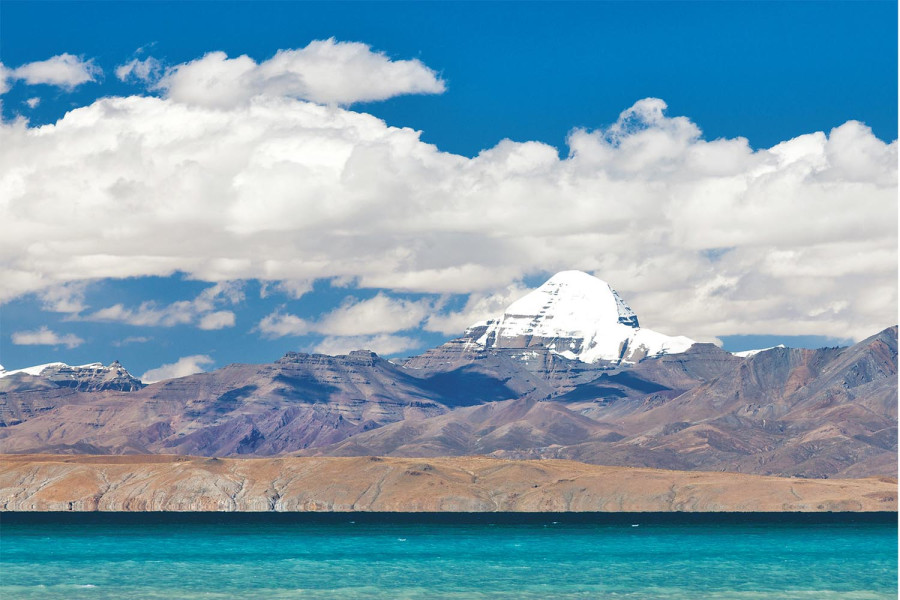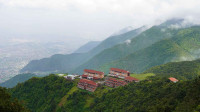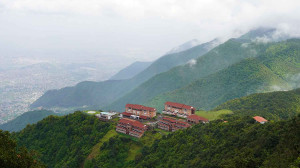Money
Nepali airline begins aerial pilgrimage tour of Kailash Manasarovar at 27,000ft
The flight, however, is limited to Nepal’s airspace as Nepali airlines have no permission from China to fly into Tibet.
Sangam Prasain
For decades, Beijing has ignored Kathmandu’s request to permit aerial sightseeing of Mount Kailash and Manasarovar lake in Tibet, China. According to tour operators, this untapped sector could offer a multi-million-dollar opportunity for Nepal. But they seem to have found an alternative.
The 6,638-metre tall diamond-shaped Mount Kailash, and Manasarovar, a huge freshwater lake at 4,556 metres, are known as the most sacred places in Hindu, Jain, Buddhist and Bon religions.
The holy mountain is revered as the abode of Lord Shiva, the third god of Hindu trinity.
Until 2019, every year, from May to October, a large number of devotees, mostly from India, used to travel to the sacred place.
Last year, Nepali tour operators said they had received over 50,000 bookings from Indian pilgrims for the Kailash-Manasarovar pilgrimage, as Beijing opened its border three years after its closure in 2020 due to the Covid pandemic.
However, Tibetan authorities abruptly stopped Indian visitors from going there.
On Monday, Shree Airlines operated a first-of-its-kind aerial pilgrimage tour of the holy places, making the pilgrims’ dream come true without a Chinese visa. There were 38 Indian tourists on board the chartered flight.
“This is a start. We expect there to be more demand,” said Anil Manandhar, corporate manager at Shree Airlines. “Based on the demand, we will make it a regular flight, just like the popular Mount Everest view flight.”
“The Kailash-Manasarovar view flight will indeed be a new product and boost religious tourism in Nepal.”
Another pilgrimage flight is scheduled for Monday, he said.
The Kailash-Manasarovar view flight, however, is conducted inside Nepal’s border as Beijing doesn’t allow Nepali airlines to fly over its territories.
According to Shree Airlines, the total flight time is 1 hour 10 minutes.
The flight starts at Nepalgunj in the southern plains. Shree Airlines conducts a 10-minute flight at 27,000 feet for the passengers seated on the left side of the plane and circles back to Simikot in Humla before returning to offer another 10 minutes of view for the passengers seated on the right side.
“The project came through after six months of preparations,” said Manandhar.
For a long time, the Nepal government has been requesting “circle navigation flight” for Nepali helicopters to Kailash-Manasarovar where hundreds of pilgrims, particularly Indians, come to take ritual dips in the cleansing waters of the lake.
Mt Kailash and Manasarovar lake hold a special significance in both Hinduism and Buddhism. Taking a holy dip on the Manasarovar lake is believed to wash away the sins of a lifetime.
Monday’s pilgrimage flight was coordinated with Trip To Temples, India, Siddhartha Hospitality Group, Nepalgunj and Pathil Holidays, Kathmandu.
Through land, there are five routes to Mt Kailash and Lake Manasarovar.
One is the disputed Lipulek Pass. India has been opening the passage for a link road for the Manasarovar Yatra from Dharchula to Lipulek, known as the Kailash-Manasarovar Yatra Route.
Nathu-la in Sikkim, India is another. However, these routes are the longest and most expensive. It takes nearly three weeks to reach the holy place using these routes, and the trip is difficult too.
Moreover, only a few pilgrims use these routes as they need to obtain a special permit from the Indian government.
Nepal offers three routes to Kailash Manasarovar through the Tatopani and Rasuwagadhi border points. After the Chinese government closed these border points, Nepalgunj became the key gateway.
The Nepalgunj-Simikot-Hilsa-Mansarovar route is the shortest, and the itinerary is easy and affordable. Travellers usually fly from Nepalgunj to Simikot by fixed-wing aircraft and then take a helicopter to Hilsa on the border with Tibet, China.
After crossing Karnali, pilgrims are taken by motor vehicles to China.
Due to the high altitude, pilgrims acclimatise for one to two days in Purang, also known as Taklakot—the first city in Tibet.
As Nepalgunj has become a major gateway, more than a dozen luxury hotels have sprung up here to cater to Indian visitors.
But Beijing’s restriction on Indian pilgrims disappoints them.
“The aerial pilgrimage is a new concept. It’s cost-effective and less time-consuming. And there is no need to obtain a Chinese visa,” said Keshav Neupane, regional director of the Siddhartha Business Group.
“Besides, for elderly people who cannot trek through the mountains, aerial tour is the best alternative. They can view Mount Kailash and Mansarovar Lake in one go.”
He said since the first flight on Monday, there has been a significant increase in inquiries from India. “We have planned to operate the aerial tour every Monday, and if the demand rises, we plan to operate daily.”
Prices for a 14-day Kailash Manasarovar Yatra package by land route start at IRs185,000 a person.
Travellers flying from Nepalgunj to Simikot and onwards to Hilsa and then journeying overland to Kailash Manasarovar pay IRs225,000 each.
A tour package involving flying from Kathmandu to Lhasa costs IRs320,000 for Indians and $4,000 for other tourists.
According to Neupane, under their promotional package, the aerial tour would cost Rs36,000 a person on the window seat.
For both the window and its accompanying non-window seats, the cost for two people has been fixed at Rs50,000.




 6.3200000000001°C Kathmandu
6.3200000000001°C Kathmandu















